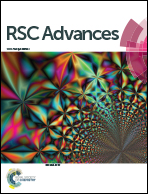Performance and coke species of HZSM-5 in the isomerization of styrene oxide to phenylacetaldehyde
Abstract
The performance and coke species of HZSM-5 in the isomerization of styrene oxide to phenylacetaldehyde was investigated under gas phase, free of solvents. The reaction showed higher catalytic stability and phenylacetaldehyde selectivity at around 300 °C, lower feed rate (e.g., WHSV = 1.2–3 h−1) and higher flow rate of carrier gas (e.g., 120 mL min−1). Based on FT-IR spectra, the dimer formed via aldol condensation of phenylacetaldehyde was one of the precursors of coke species. TG results showed that there were two types of coke species. The soft coke, which can be removed via desorption between 200–400 °C, had less influence on the catalytic stability. The hard coke, which had a certain degree of crystallization (i.e., pregraphite-like carbon presenting in XRD patterns) and must be completely removed via burning with oxygen, causes major catalyst deactivation.



 Please wait while we load your content...
Please wait while we load your content...